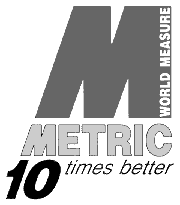The Metric System
(and related international standards)
 It's
ridiculous and embarrassing that the the U.S. has not converted to the metric
system. The Metric System, also know as Le Système International
d'Unités or the International System of Units (SI), is used by virtually every
country in the world except the United States. We continue to cling to an
outdated, illogical and confusing system based on the old British measurements
(which even the British have since abandoned in
favor of the metric system).
It's
ridiculous and embarrassing that the the U.S. has not converted to the metric
system. The Metric System, also know as Le Système International
d'Unités or the International System of Units (SI), is used by virtually every
country in the world except the United States. We continue to cling to an
outdated, illogical and confusing system based on the old British measurements
(which even the British have since abandoned in
favor of the metric system).
It seems to me that our failure to use what is unquestionably a superior system of measurement is one example of a uniquely American arrogance and stubborn conservatism. This unfortunate trait manifests itself in an almost complete inability to acknowledge the possibility that other countries might actually do some things better than us and that we can learn from the successes of others. But we live in an interconnected world, and it just doesn't make sense for the U.S. to do things one way while the rest of the world does things a different (and far better) way.
TABLES OF METRIC UNITS OF MEASUREMENT
(adapted from:
http://ts.nist.gov/ts/htdocs/230/235/appxc/appxc.htm)
In the metric system of measurement, designations of multiples and sub-divisions of any unit may be arrived at by combining with the name of the unit the prefixes deka, hecto, and kilo meaning, respectively, 10, 100, and 1000, and deci, centi, and milli, meaning, respectively, one-tenth, one-hundredth, and one-thousandth.
In some of the following metric tables, some such multiples and sub-divisions have not been included for the reason that these have little, if any currency in actual usage. In certain cases, particularly in scientific usage, it becomes convenient to provide for multiples larger than 1 000 and for subdivisions smaller than one-thousandth. Accordingly, the following prefixes have been introduced and these are now generally recognized:
| yotta (Y) | meaning 1024 | deci (d) | meaning 10-1 | |
| zetta (Z) | meaning 1021 | centi (c) | meaning 10-2 | |
| exa (E) | meaning 1018 | milli (m) | meaning 10-3 | |
| peta (P) | meaning 1015 | micro (u) | meaning 10-6 | |
| tera (T) | meaning 1012 | nano (n) | meaning 10-9 | |
| giga (G) | meaning 109 | pico (p) | meaning 10-12 | |
| mega (M) | meaning 106 | femto (f) | meaning 10-15 | |
| kilo (k) | meaning 103 | atto (a) | meaning 10-18 | |
| hecto (h) | meaning 102 | zepto (z) | meaning 10-21 | |
| deka (da) | meaning 101 | yocto (y) | meaning 10-24 |
|
Units of Length 10 millimeters (mm) = 1 centimeter (cm) Units of Liquid Volume 1 liter = 1 cubic decimeter |
Units of Area 100 square millimeters (mm2) = 1 square centimeter (cm2) Units of Mass 10 milligrams (mg) = 1 centigram (cg) |
|
Units of Volume 1000 cubic millimeters (mm3) = 1 cubic centimeter (cm3) |
|
When you arrived at this page, Greenwich Mean Time (GMT) was:
![]() .
.
Please note that the views expressed in these pages are mine, and mine alone. They do not necessarily reflect the views other members of my family, past or present employers, or any other person or group with which I have been affiliated.
LINKS
The U.S.
Metric Association
The Metric Program
of the National Institute of Standards and Technology (NIST)
International Standard
for paper sizes based on ISO 216 Standard
Back to our Home Page
Last Updated
22 July 2005
Copyright 2001